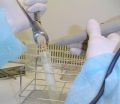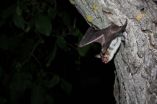(Press-News.org) DNA has the nasty habit of getting tangled and forming knots. Scientists study these knots to understand their function and learn how to disentangle them (e.g. useful for gene sequencing techniques). Cristian Micheletti, professor at the International School for Advanced Studies (SISSA) in Trieste and his team have been carrying out research in which they simulate these knots and their dynamics. In their latest paper, just published in the journal Soft Matter, Micheletti together with Marco Di Stefano, first author and PhD student at SISSA, and colleagues from Ljubljana and San Diego devised and tested a method based on the application of electric fields and "optical tweezers".
DNA is in fact an electrically charged molecule which reacts to the presence of opposing charges. "In our theoretical-computational study we took into account a "stretched-out" strand of DNA, with its ends secured by two optical tweezers that serve as anchors to keep them apart. We succeeded in moving the knot, inserted into the configuration, by applying an electric field", explains Micheletti. "Try to imagine holding one end of a knotted rope so that the rope is suspended above the ground: by shaking it gently you can make the knot slide down with the help of gravity. Something like that takes place in our experiments".
"Our work", concludes Micheletti, "provides useful information for setting up new experiments where the movement of the DNA knots can be controlled from the outside". In fact, in studies of this kind carried out to date the movement of the knot was "stochastic", that is, produced by thermal noise, the random movement of atoms caused by the rise in temperature of the system, and never directly controlled by the investigator.
INFORMATION:
The electric slide dance of DNA knots
How to drive DNA knots with an electric potential
2014-07-23
ELSE PRESS RELEASES FROM THIS DATE:
Ancient genetic material from caries bacterium obtained for the first time
2014-07-23
Streptococcus mutans, one of the principal bacteria that cause dental caries, has increased the change in its genetic material over time, possibly coinciding with dietary change linked to the expansion of humanity. This is highlighted in a study by researchers from the Universitat Autònoma de Barcelona (UAB) and the Laboratorio Nacional de Genómica para la Biodiversidad (National Laboratory of Genomics for Biodiversity) in Mexico who, for the first time, have sequenced genetic material from this bacterium in populations from the past. Increase in genetic diversity has ...
Linking television and the Internet
2014-07-23
The panel discussion is getting heated -- but what exactly is in the new proposed law that the experts on TV are arguing about so vigorously? Up until now, spontaneous questions such as these that arise during a program had to be clarified through a viewer's own research on the Internet.
If it's up to researchers at the Fraunhofer Institute for Intelligent Analysis and Information Systems IAIS in Sankt Augustin, Germany, viewers will no longer have to look up such additional information in the future. In the project "LinkedTV", the institute is working with eleven partners ...
Bats use the evening sky's polarization pattern for orientation
2014-07-23
This news release is available in German.
Animals can use varying sensory modalities for orientation, some of which might be very different from ours. Some bird species for example take the polarization pattern produced by sunlight in the atmosphere to calibrate their orientation systems. Now researchers from the Max Planck Institute for Ornithology in Seewiesen, Germany, and Queen's University Belfast have discovered with colleagues from Israel that a night active mammal, the greater mouse-eared bat, has the capability to orient using polarized light. These bats ...
Rising temperatures hinder Indian wheat production
2014-07-23
Geographers at the University of Southampton have found a link between increasing average temperatures in India and a reduction in wheat production.
Researchers Dr John Duncan, Dr Jadu Dash and Professor Pete Atkinson have shown that recent warmer temperatures in the country's major wheat belt are having a negative effect on crop yield. More specifically, they found a rise in nighttime temperatures is having the most impact.
Dr Jadu Dash comments: "Our findings highlight the vulnerability of India's wheat production system to temperature rise, which is predicted to ...
A crystal wedding in the nanocosmos
2014-07-23
Researchers at the Helmholtz-Zentrum Dresden-Rossendorf (HZDR), the Vienna University of Technology and the Maria Curie-Skłodowska University Lublin have succeeded in embedding nearly perfect semiconductor crystals into a silicon nanowire. With this new method of producing hybrid nanowires, very fast and multi-functional processing units can be accommodated on a single chip in the future. The research results will be published in the journal Nano Research.
Nano-optoelectronics are considered the cornerstone of future chip technology, but the research faces major ...
Intestinal parasites are 'old friends,' researchers argue
2014-07-23
Intestinal parasites such as tapeworms, hookworms and a protist called Blastocystis can be beneficial to human health, according to a new paper that argues we should rethink our views of organisms that live off the human body.
To prove the point, paper co-author Julius Lukeš even ingested three developmental stages of a large species of tapeworm called Diphyllobothrium latum. After more than a year with the tapeworms, which might have grown to be as long as four metres each by now, he says he feels fine.
"I knew there was no risk," he says.
Lukeš, a senior fellow ...
Toward an oral therapy for treating Alzheimer's disease: Using a cancer drug
2014-07-23
Currently, no cure exists for Alzheimer's disease, the devastating neurological disease affecting more than 5 million Americans. But scientists are now reporting new progress on a set of compounds, initially developed for cancer treatment, that shows promise as a potential oral therapy for Alzheimer's. Their study appears in ACS' Journal of Medicinal Chemistry.
Carlo Ballatore, Kurt R. Brunden and colleagues explain that in a healthy brain, the protein known as tau binds to and stabilizes microtubules, which are cellular components made of protein inside cells. Microtubules ...
Anti-pain agent shrinks oral cancers, leaves healthy tissues alone
2014-07-23
SAN ANTONIO (July 22, 2014) — Mouse models of human oral cancer treated with an agent called capsazepine showed dramatic tumor shrinkage without damage to surrounding tissues, researchers from the School of Dentistry and School of Medicine at The University of Texas Health Science Center at San Antonio found. The Health Science Center has claimed intellectual property on results of the study, which is described in the journal Oral Oncology.
Late diagnosis, low survival
Oral squamous cell carcinoma is the eighth most common cancer in the U.S. with 40,000 new cases and ...
HIV clinic-based audio project emphasizes the power of patient voices
2014-07-23
(MEMPHIS, Tenn. – July 22, 2014) The voice on the recording was low and calm as the speaker recounted the telephone call that brought the news he was infected with the human immunodeficiency virus (HIV) that causes AIDS: "My heart just stopped for a little bit and next thing you know I was on the floor flat on my face boohooing, crying like a baby."
Yet the message was hopeful when the recording ended less than 10 minutes later. "Don't feel like this is the end of you . . . because it is just God setting you up for something greater," the anonymous speaker tells an unseen ...
Chinese scientists search for evidence of dark matter particles with new underground PandaX detector
2014-07-23
The new PandaX facility, located deep underground in the southwestern Chinese province of Sichuan, hosts a large liquid-xenon detector designed to search for direct evidence of dark matter interactions with the nuclei of xenon and to observe 136Xe double-beta decay.
The detector's central vessel was designed to accommodate a staged target volume increase from an initial 120 kg (stage I) to 0.5 t (stage II) and ultimately to a multi-ton scale.
The technical design of the PandaX facility and detector is outlined in a new paper co-authored by Ji Xiangdong, of the Institute ...
LAST 30 PRESS RELEASES:
SRI chosen by DARPA to develop next-generation computational design of metallic parts and intelligent testing of alloys
NJIT engineers muffle invading pathogens with a 'molecular mask'
Perinatal transmission of HIV can lead to cognitive deficits
The consumption of certain food additive emulsifiers could be associated with the risk of developing type 2 diabetes
New cancer research made possible as Surrey scientists study lipids cell by cell
Bioluminescence first evolved in animals at least 540 million years ago
Squids’ birthday influences mating
Star bars show Universe’s early galaxies evolved much faster than previously thought
Critical minerals recovery from electronic waste
The move by Apple Memories to block potentially upsetting content illustrates Big Tech’s reach and limits, writes Chrys Vilvang
Chemical tool illuminates pathways used by dopamine, opioids and other neuronal signals
Asian monsoon lofts ozone-depleting substances to stratosphere
PET scans reveal ‘smoldering’ inflammation in patients with multiple sclerosis
Genetics predict type 2 diabetes risk and disparities in childhood cancer survivors
Health information on TikTok: The good, the bad and the ugly
New study points to racial and social barriers that block treatment for multiple myeloma
Rensselaer researcher finds that frog species evolved rapidly in response to road salts
A new chapter in quantum vortices: Customizing electron vortex beams
Don’t be a stranger – study finds rekindling old friendships as scary as making new ones
There’s no ‘one size fits all’ when it comes to addressing men’s health issues globally
Comparison of the “late catch-up” phenomenon between BuMA Supreme and XIENCE stents through serial optical coherence tomography at 1–2 month and 2 year follow-ups: A multicenter study
Marine plankton communities changed long before extinctions
Research reveals tools to make STEM degrees more affordable
Q&A: UW research shows neural connection between learning a second language and learning to code
Keane wins 2024 Gopal K. Shenoy Excellence in Beamline Science Award
Livestock abortion surveillance could protect livelihoods and detect emerging global pathogens
Optimal timing maximises Paxlovid benefits for treating COVID-19
IU researchers receive $4.8 million grant to study the role of misfolded protein TDP-43 in neurodegenerative diseases
DOE’s Office of Science Graduate Student Research Program selects 86 outstanding US graduate students
This tiny chip can safeguard user data while enabling efficient computing on a smartphone
[Press-News.org] The electric slide dance of DNA knotsHow to drive DNA knots with an electric potential





